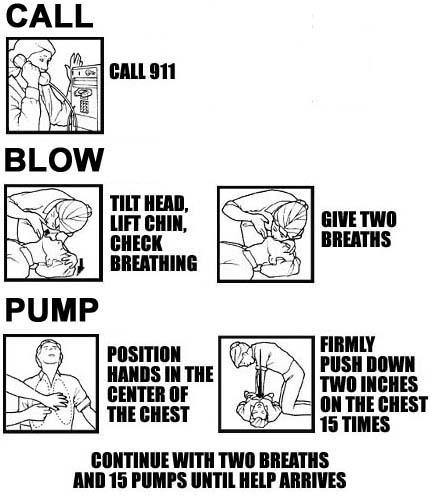Basic First Aid and Street Medics
CPR
for Adults in Three Simple Steps
(Please try to attend
a CPR training course)

1. CALL
Check the victim for unresponsiveness. If there is no response, Call 911 and return to the victim. In most locations the emergency dispatcher can assist you with CPR instructions.
2. BLOW
Tilt the head back and listen for breathing. If not breathing normally cover the mouth with yours and blow until you see the chest rise. Give 2 breaths. Each breath should take 2 seconds.
3. PUMP
If the victim is still not breathing normally, coughing or moving, begin chest compressions. Push down on the chest 11/2 to 2 inches 15 times right between the nipples. Pump at the rate of 100/minute, faster than once per second.
CONTINUE WITH 2 BREATHS AND 15 PUMPS UNTIL HELP ARRIVES
NOTE: This ratio is the same for one-person & two-person CPR. In two-person CPR the person pumping the chest stops while the other gives mouth-to-mouth breathing.
What complications can occur?
Vomiting is the most frequently encountered complication of CPR. If the victim starts to vomit, turn the head to the side and try to sweep out or wipe off the vomit. Continue with CPR.
The spread of infection from the victim to the rescuer is exceedingly rare. Most cardiac arrests occur in people's homes - relatives or friends will be the ones needing to do CPR. Even CPR performed on strangers has an exceedingly rare risk of infection. There is NO documentation of HIV or AIDS ever being transmitted via CPR.
Checking The Pulse
The pulse check is no longer taught or expected of laypersons. Instead, if you see no signs of life (defined as breathing normally, coughing or moving) you should begin to pump on the chest. Please note that the pulse check is still expected of health case providers.
CPR for Children (Ages 1-8)
CPR for children is similar to performing Quick CPR for adults. There are, however, 4 differences.
1) If you are alone with the child give one minute of CPR before calling 911
2) Use the heel of one hand for chest compressions
3) Press the sternum down 1 to 1.5 inches
4) Give 1 full breath followed by 5 chest compressions
CPR for Infants (Age <1)
Shout and Tap
Shout and gently tap the child on the shoulder. If there is no response, position the infant on his or her back.
Open The Airway
Open the airway using a head tilt lifting of chin. Do not tilt the head too far back.
Give 2 Breaths
If the baby is NOT breathing give 2 small gentle breaths. Cover the baby's mouth and nose with your mouth. Each breath should be 1.5 to 2 seconds long. You should see the baby's chest rise with each breath.
Give 5 Compressions
Give five gentle chest compressions at the rate of 100 per minute. Position your 3rd and 4th fingers in the center of the chest half an inch below the nipples. Press down only 1/2 to 1 inches.
Repeat
Repeat with 1 breath and 5 compressions. After one minute of repeated cycles call 911. If you feel a pulse return give one breath every 3 seconds and discontinue chest compressions.